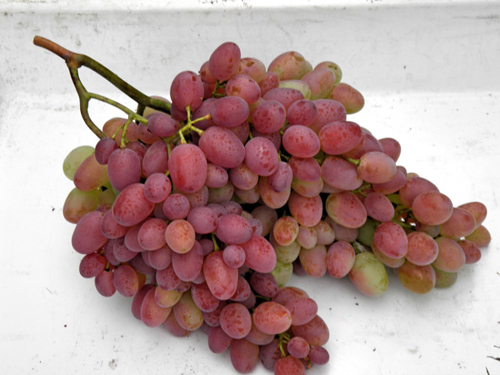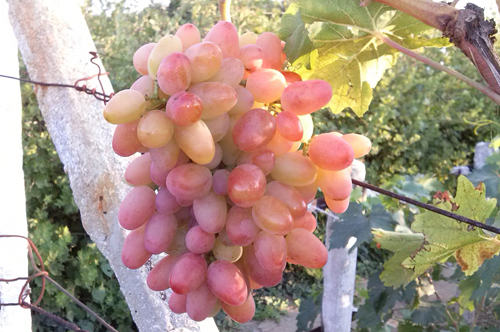Helios grape variety
Helios is a very attractive hybrid form of table grapes, created by the hands of the famous domestic amateur breeder Viktor Krainov. Viktor Nikolaevich began to be engaged in viticulture since Soviet times, and in the 90s of the last century, after meeting the famous scientist Ivan Kostrikin, he became interested in breeding new grapevine hybrids. During his rich creative life, Krainov created dozens of author's novelties, some of which have become a symbol of national selection, and even at different times have successfully passed the state variety testing.

The peak of the breeder's activity came in the late 90s - early 2000s, and in this short time he managed to get new grape varieties not only with the participation of old varieties, but also to use his own creations for hybridization already as parental forms. One of these, in the second generation of "Kraynovsky" brainchildren, is our hero, who received the name Helios. He was born as a result of pollination of a famous variety. Arcadia pollen of Kishmish Nakhodka, bred by the breeder earlier. As a result, grapes, amazing in their aesthetic qualities, were presented to the court of winegrowers, which, moreover, are distinguished by early maturity, good taste and delicate muscat aroma. Bearing in mind its origin, it is often also called Arcadia pink.
Over the years that have passed since its inception, the variety has become widespread in our country and neighboring countries, both in individual farms and in farm plantings. In 2015, our hero was officially included in the State Register of Breeding Achievements of the Russian Federation, and was recommended for cultivation in garden plots.
Agrobiological characteristics
The bushes are characterized by high vigor of growth, both in grafted and in self-rooted culture. The crown of a young shoot is smooth, shiny, bronze-green in color, with a similar color to young leaves. The formed leaves are large enough, dark green, stretched in width, usually consisting of five lobes, the dissection between which ranges from weak to medium. The surface of the leaf blade of grapes is smooth or slightly bubbly, the profile is wavy, on the back side there is a noticeable cobweb pubescence. Upper side notches of moderate depth, open slit-like or closed, with almost no clearance. The lower notches are somewhat smaller, while the shape can also be slit-like, or have the appearance of an incoming corner. The petiolate notch is in most cases open vaulted with a sharp bottom, but sometimes lyre-shaped ones are also found. The petioles are approximately equal to the length of the main vein of the leaf, their color is greenish-pink. The teeth along the perimeter of the leaves are predominantly sawtooth, with slightly curved edges and pointed tops. The flowers of Helios are bisexual, which allows them to pollinate well in any weather and form berries that are not subject to peas. The shedding of buds and ovaries was also not noticed in the variety. The maturation of the one-year growth proceeds well, and the vine becomes reddish-brown in color.

The size of the grape bunches is very large, the shape is cylindro-conical, the structure is moderately loose, the average weight is 700-900 grams, individual clusters are up to one and a half kilograms or more. The combs are rather long, herbaceous, light green. Egg-shaped berries with a blunt end also grow impressive sizes, reaching a length of 30-35 mm, and in diameter - 22-24 mm. They are painted in a delicate pink color and are covered from the outside with a thin layer of protective pruin. Within the bunch, the grapes are very aligned, which gives the fruit a very elegant appearance. The standard berry weight ranges from 12-15 grams. Due to the location not too dense in relation to each other, they do not deform or wrinkle.The consistency of the pulp is juicy-fleshy, quite dense, the taste is pleasant, harmonious, the aroma clearly shows the soft tones of nutmeg. Freshly squeezed juice is colorless, the sugar content in it is 15-16 g / 100 ml, titratable acids - 5-6 g / l. In some years, a slow accumulation of the sugar content of the berries is possible, which is why some growers express critical remarks about the variety. The skin is of medium thickness and firmness, while remaining easy to chew and eat. Only 1-2 small seeds are formed in the pulp of grapes, and no particular negative effect from them on the palatability was noticed. The average tasting marks that Helios earned during the state variety testing were 9 points.
High-quality, large-fruited, attractive in appearance and excellent from a gastronomic point of view, the harvest is excellent for fresh consumption. It evokes only positive emotions among consumers, and is one of the first to be sold on the market. For its high demand, it is respected by many farmers, who, moreover, are impressed by the early ripening of the variety, which allows them to start selling grapes during a period of relatively high prices for it. An additional advantage and positive characteristic is the good transportability of the harvested bunches, which contributes to the expansion of the sales market due to the possibility of transporting crops over long distances without losing their commercial qualities. Our hero behaves well during storage. If you create an optimal microclimate in the room or use refrigerators, you can achieve excellent keeping quality. In private households where grapes are grown for their own consumption, another area of using the variety is its processing in the process of home canning. The resulting compotes, jams and juices, excellent in taste and aroma, will come in handy in winter and early spring, when the body is experiencing an acute shortage of vitamins and microelements.

Our hero deservedly belongs to the early ripening varieties, thanks to the opportunity to feast on ripe berries in early August. It should be noted right away that this harvesting period is relevant for the southern, traditionally viticultural regions, while when the culture moves northward, the ripening time shifts closer to autumn. In this regard, it is more convenient to count down from the time of budding in the spring, after which about 110 days pass by Helios before the onset of the removable ripeness of the bunches. The sum of active temperatures during this period does not exceed 2250-2350 ° С, which indicates the possibility of cultivating the variety in the middle zone of the country,
The yield of the variety in large-scale plantings is 120-130 centners per hectare, while individual bushes on personal plots, being provided with good care, are capable of producing up to 20 kg of sunny berries per season. The bushes are not prone to a particular overload with the harvest, however, like most large-fruited varieties, they need to ration the number of bunches on the shoots. If this is not done, then the plants can still begin to show negative signs of overuse. The most typical of these are a decrease in the growth and ripeness of shoots, as well as a decrease in the size of fruits, a deterioration in sugar accumulation in them and the appearance of a watery pulp.The most unpleasant result is a decrease in the already not outstanding frost resistance of the grape vine, which can lead to severe damage to it in the winter.
Ripe bunches are often left hanging on the bushes waiting for their turn to be sold, or to achieve the best tasting conditions. In this respect, Helios shows itself excellently due to its lack of tendency to crack or raspberries. Only in the most extreme cases, when a period of extreme drought is followed by heavy rains, can damage to some grapes occur, but the presence of watering or mulching the soil under the bushes will minimize this risk. Wasps also do not cause much damage to the crop, which greatly simplifies its protection compared to other varieties.
Agrotechnical features
Our hero does not make overly specific requirements for his cultivation, for which he is loved by many winegrowers, including those with modest experience in cultivation.
Grape bushes are placed, if possible, on the southern gentle slopes, or on the plains in those regions where there is no shortage of warmth and sunlight. In areas infected with phylloxera, reproduction is carried out by grafted seedlings on stable rootstocks, with which our hero has a good affinity. In areas free from root aphids, planting with rooted cuttings is successfully practiced.
The variety, as a rule, requires warming of the vine for the winter, and therefore the main type of formations for it are stampless covering ones - like an oblique cordon or a multi-arm fan. In spring pruning, the fruit arrows are shortened by an average (by 6-8 eyes), and the total load on the bush is given up to 35 buds. Subsequently, it is necessary to produce a fragment of sterile shoots and thinning the number of inflorescences on grape vines. Helios is moderately resistant to fungal diseases, and therefore requires 3-4 fungicide treatments per season.








